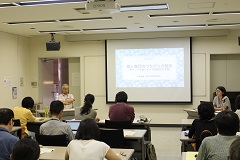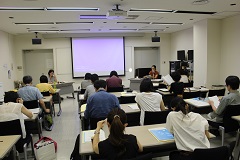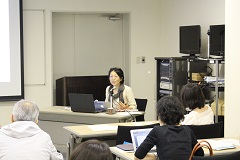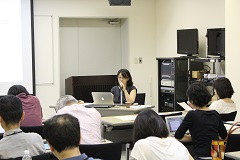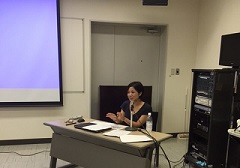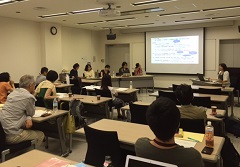 研究会報告 2016
研究会報告 2016
Workshop Report
MINDAS 2016 the Fourth Joint Workshop
“Pattern and Intellectual Property – From the Front Lines of Textile Production in India”
| Date: | Saturday, 4th February 2017. 13:00-19:00 |
| Venue: | National Museum of Ethnology, Osaka |
|
Textile products are not confined to practical use as clothing. Textiles are used as emblems to express identity and authority. Indeed, they sometimes function as currency. They can, in other words, play important social, economic, political, and religious roles. In the world of fashion, Indian textiles embody rare materials and fascinating techniques and patterns rooted in Indian culture. They are used in clothing that is closely connected to society and religion. In many cases, they are easily commodified, which raises the issue of the extent to which the essence of locally produced textiles can be abstracted. Textile products spread patterns far and wide. Superficially distinctive, these patterns are easily copied, allowing “Indian style” products to flood global markets. At this symposium, based on fieldwork in regions where Indian textiles are produced, social and cultural anthropologists and ethnologists will present cases illustrating these trends, with consideration of the relation between imitation of traditional patterns and issues of intellectual property. |
|
| Presenter: | 1. Yoko Ueba (National Museum of Ethnology) “Rabari Embroidery and Dress – Use of Design in Other Applications” |
| 2. Miwa Kanetani “Woodblock Printed Textile Connected with Copy Technique” |
|
| Summary: | 1. Yoko Ueba This presentation specifically emphasizes the uses of textiles among the Rabari in the Kutch district of Gujarat state, with clarification of the use of textiles as status symbols and examination of the imitation of patterns from this perspective. I have indicated two events as drivers of major changes in Rabari society: the legal prohibition of embroidery and the great earthquake in western India. I have also analyzed the effects of changes on Rabari dress and how Rabari dress is decorated. From these events, Rabari textiles have come to include those that imitate traditional patterns, produced by textile guilds of artisans specializing in weaving and dyeing. Because these textiles are created by expert artisans using expensive materials, they are regarded as precious by Rabari society. However, these events also brought a large inrush into the market of inexpensive, mass-produced cotton and synthetic fiber printed textiles that imitate traditional patterns. These printed textiles spread rapidly through Rabari society, replacing the textile products that were used previously. In the Indian social context, which assigns a clear status to the motifs applied to textiles, these mass-produced textiles do not accurately resemble patterns found in Rabari women’s embroidery. Textile design (form, pattern, and color) is a visual marker of social status. One can readily imagine that the original fabrics are copied, but mass-produced printed textiles only superficially resemble traditional designs. Consequently, in Rabari society, little attention is devoted to such questions of whether they are made of natural or synthetic materials or hand or machine made. Design remains the most important characteristic of these copies. |
| 2. Miwa Kanetani This presentation describes the issue of property rights to specific patterns of handmade textiles in Gujarat, India. Using a hand woodblock printing technique, this textile, Ajrakh, has been produced by the Muslim artisan caste, Khatri, for garments of local pastoral people for four hundred years. Today, Ajrakh producers are preparing for Geographical Identification (GI) registration to prevent others from taking intellectual property rights of Ajrakh. The issue began after a natural calamity struck this area. Artisans who were adversely affected by the earthquake of 2001 and who thereby lost their livelihood constructed a new village to shift their block printing industry. They named Ajrakh as their new village. Ajrakh became famous by seizing this opportunity of post-disaster development. However, as it became famous, copied products of Ajrakh are made by screen printing and machine printing with chemical dye circulated throughout the area. Producers of Ajrakh started to call their own products “Real Ajrakh”, and labeled copied products of Ajrakh as “No Real Ajrakh” or “Copy Ajrakh”. Nevertheless, clearly identifying which is real and which is not real has become difficult because the hand woodblock printing technique was presumably invented to repeat the specific pattern many times. In fact, machine printing was developed based on Indian woodblock printing in Europe. For that reason, woodblock printing are connected with copying techniques. The background of the property rights controversy of Ajrakh is fundamentally related to its technique. |
2016年度MINDAS第1回公開セミナー
下記の通り2016年度MINDAS第1回公開セミナーを開催します。
奮ってご参加くださいますよう、ご案内申し上げます。
奮ってご参加くださいますよう、ご案内申し上げます。
| 日時: | 2016年11月20日(日)10:00~12:00 |
| 場所: | 国立民族学博物館 第4セミナー室(本館2階) [大阪府吹田市千里万博公園10-1 Tel. 06-6876-2151(代)] |
| テーマ: | “Bodily Philanthropy as Partonomic Critique” |
| プログラム: | 10:00~10:05 報告者紹介 松尾 瑞穂(国立民族学博物館・准教授) |
| 10:05~11:05 報告 “Bodily Philanthropy as Partonomic Critique” Jacob Copeman(The University of Edinburgh・Senior Lecturer/国立民族学博物館・外来研究員) |
|
| 11:05~11:15 Tea break |
|
| 11:15~11:30 コメント 島薗 洋介(大阪大学グローバルコラボレーションセンター・講師) |
|
| 報告要旨: | This paper describes a number of scenes of activist critique that find their logic in acts of bodily giving over. The given over illuminates gaps between the given and the withheld that become the basis of critical social commentary. Crucially, the materials given over are, or make reference to, human biological substances (actual blood and metaphorical hearts). The critiques they stage are of absences and deficits: I present cases where large paper hearts donated by survivors of the 1984 Bhopal Gas Disaster to the Prime Minister of India signal his lack of one, where donated human blood critiques others’ unwillingness to do so, where acts of blood donation critique and protest communal violence, and where similar acts of giving over simultaneously highlight a deficit in familial affects and resuscitate damaged relational forms. In other words, I seek to show how the gift that is given critiques that which is ungiven: the care not provided by the Indian state for Bhopal survivors, the family members unwilling to donate blood for their transfusion-requiring relative, etc. I aim to illustrate how critique can operate philanthropically by way of partonomic relations between the given and not given. It is partonomy, I suggest, that makes philanthropy critical. |
★本セミナーはどなたでもご参加いただけますが、資料準備等の都合上参加を希望される方はMINDAS事務局(mindas@idc.minpaku.ac.jp)まで事前連絡をお願いいたします。
Workshop Report
MINDAS 2016 the Third Joint Workshop
“Performing arts and marginalized communities in South Asia”
| Date: | Saturday, 19th November 2016. 13:00-19:00 |
| Venue: | National Museum of Ethnology, Osaka |
| Presenter: | 1. Yoshitaka Terada “Introduction” |
| 2. Fumiko Imai “Occupation of the Gandharba caste and their tool/instrument, Sārangi” |
|
| 3. Emi Okada “A New Movement in Naga’s Music Culture: Popularization of folk songs and recent developments in the Nagaland music industry” |
|
| Summary: | 1. Yoshitaka Terada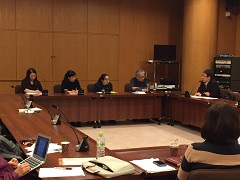 Ethnomusicological study of South Asian performing arts has targeted classical traditions of music and dance as primary subjects of research. Although the generated body of scholarship has contributed greatly to the understanding of music as culture, revealing unexplored aspects of classical performing arts such as context-based performance practice, social organization of musicians and patrons, and transmission of knowledge, it has nevertheless left a vast field of non-classical traditions that are under-represented in scholarship. Based on this premise, the current session was aimed at providing a venue for scholars who are exploring marginalized groups in performing arts for interaction. A film on Dalit drumming from Tamil Nadu, This is Music: Reclaiming an Untouchable Drum, was first screened to set a tone for discussion. The film’s director, Zoe Sherinian, is a staunch critic of Western scholarship predicated on classical traditions and is an advocate of engaged/activist ethnomusicology. The screening was followed by a commentary by Kurokawa Taeko (International Center for Literacy and Culture), who wrote a doctoral dissertation on the topic in 2002. After a break, two contrasting case studies from Nepal and Nagaland, India were reported respectively by Imai Fumiko and Okada Emi (see below). Finally, the general discussion began with comments by Murayama Kazuyuki (Wako University). Among the issues discussed were the relevance of the concept of activist ethnomusicology in South Asian studies, the positioning of researchers in the study of music and marginalized communities, and the roles of audiovisual media in such studies.
Ethnomusicological study of South Asian performing arts has targeted classical traditions of music and dance as primary subjects of research. Although the generated body of scholarship has contributed greatly to the understanding of music as culture, revealing unexplored aspects of classical performing arts such as context-based performance practice, social organization of musicians and patrons, and transmission of knowledge, it has nevertheless left a vast field of non-classical traditions that are under-represented in scholarship. Based on this premise, the current session was aimed at providing a venue for scholars who are exploring marginalized groups in performing arts for interaction. A film on Dalit drumming from Tamil Nadu, This is Music: Reclaiming an Untouchable Drum, was first screened to set a tone for discussion. The film’s director, Zoe Sherinian, is a staunch critic of Western scholarship predicated on classical traditions and is an advocate of engaged/activist ethnomusicology. The screening was followed by a commentary by Kurokawa Taeko (International Center for Literacy and Culture), who wrote a doctoral dissertation on the topic in 2002. After a break, two contrasting case studies from Nepal and Nagaland, India were reported respectively by Imai Fumiko and Okada Emi (see below). Finally, the general discussion began with comments by Murayama Kazuyuki (Wako University). Among the issues discussed were the relevance of the concept of activist ethnomusicology in South Asian studies, the positioning of researchers in the study of music and marginalized communities, and the roles of audiovisual media in such studies.
|
2. Fumiko Imai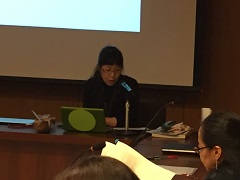 The occupation of Gandharba (Gaine), a lower occupational caste in Nepal, is singing while traveling from village to village. They use a fiddle-like instrument called sārangi, their only occupational tool for living. Because of their occupational features, Gandharba are often regarded as a musician caste, especially by foreign researchers whose works have examined Gandharba’s musical aspects. However, “music” does not fully capture the complex features of their performances. Video clips of Gandharba performances recorded during the author’s fieldwork in 2006 exhibit that Gandharba performances are in fact dynamic and variable, depending on various audience groups and circumstances.
The occupation of Gandharba (Gaine), a lower occupational caste in Nepal, is singing while traveling from village to village. They use a fiddle-like instrument called sārangi, their only occupational tool for living. Because of their occupational features, Gandharba are often regarded as a musician caste, especially by foreign researchers whose works have examined Gandharba’s musical aspects. However, “music” does not fully capture the complex features of their performances. Video clips of Gandharba performances recorded during the author’s fieldwork in 2006 exhibit that Gandharba performances are in fact dynamic and variable, depending on various audience groups and circumstances.This report describes the current circumstances related to the Gandharba people and sārangis, particularly addressing how their performances are used through the process of promoting the national music of Nepal. From the late twentieth century, in an attempt to exclude the influence of foreign music and to reinforce the sense of national identity, Radio Nepal, a state-run radio station established in 1951, had broadcasted variations of traditional folk songs from different villages. After one Gandharba person was recruited as an artist at the Radio in the mid-1960s, the sārangi instrument has enhanced presence in the field of Nepalese music. Nevertheless, although sārangi has been widely accepted, little change has occurred in terms of the status and social situations of most Gandharba people. What the historical changes around sārangi brought about, in the author’s view, is that images associated with sārangi are divisible into the following two: a national musical instrument on one hand, and the low-caste Gandharba’s own tool on the other. |
|
3. Emi Okada In Nagaland, a state in India near the Indo-Myanmar border, over 84% of the area’s people are Nagas [Census 2011], an aggregation of several ethnic minorities of Indo-mongoloid origin authorized by the Indian government as a Scheduled Tribe. The long struggle for Naga independence from India based on the issue of their separateness has placed Naga society at a socioeconomic disadvantage. Moreover, it has isolated and differentiated them from mainstream culture in India. From acceleration of globalization occurring after the late 90s, not only have Nagas accepted western popular music and K-pop. They have also started to assert their own musical origins and identity and to change musical media and market circulation, with connection to a cultural policy for popular music and young musicians. Actually, that policy is supported and promoted by the Music Task Force of Nagaland state government. These circumstances have brought about the popularization of folk songs handed down from generation to generation by Naga ethnic groups in the context of Naga pop culture and connection with recent developments in the Nagaland music industry.
In Nagaland, a state in India near the Indo-Myanmar border, over 84% of the area’s people are Nagas [Census 2011], an aggregation of several ethnic minorities of Indo-mongoloid origin authorized by the Indian government as a Scheduled Tribe. The long struggle for Naga independence from India based on the issue of their separateness has placed Naga society at a socioeconomic disadvantage. Moreover, it has isolated and differentiated them from mainstream culture in India. From acceleration of globalization occurring after the late 90s, not only have Nagas accepted western popular music and K-pop. They have also started to assert their own musical origins and identity and to change musical media and market circulation, with connection to a cultural policy for popular music and young musicians. Actually, that policy is supported and promoted by the Music Task Force of Nagaland state government. These circumstances have brought about the popularization of folk songs handed down from generation to generation by Naga ethnic groups in the context of Naga pop culture and connection with recent developments in the Nagaland music industry.
|
|
Workshop Report
MINDAS 2016 the Second Joint Workshop
| Date: | Saturday, 8th October 2016. 13:00-19:00 |
| Venue: | National Museum of Ethnology, Osaka |
| Presenter: | 1. Makito Minami “Transformation of Society and Social Mobility in Nepal” |
| 2. Yasuko Fujikura “Inside and Outside Marriage Norms: Migration and Kin Networks in Western Nepal” |
|
| 3. Maiko Annen “Enthusiasm for Education and Social Change in Contemporary Nepal: Specific Examination of the Daily Life of a “Good Education”-Oriented Woman” |
|
| 4. Kanako Nakagawa “Social Mobility Mediated by Mixed Concepts of Value: Case Study of Buffalo Meat Dealers in Kathmandu Valley, Nepal” |
|
| Summary: | 1. Makito Minami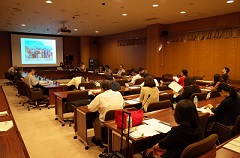 In the second joint seminar of MINDAS, we addressed aspects of social and physical mobility of people in Nepal under the context of drastic political change of the state during the last few decades. As an introduction, the author first describes salient socio-political changes since the Maoists rebellion in 1996, as well as social inclusion policies adopted as a slogan in the new Federal Democratic Republic of Nepal. After examining three recent phenomena (reservation system, social protection: cash transfer, and international labor emigration) that are apparently highly relevant to social inclusion of oppressed and backward people into civil society, results were compared with the functions of the newly introduced reservation system and social protection (earlier study). Results of this study show that remittances by international emigrant laborers reached about 22 per cent of GDP, enabling villagers to enjoy cellular telephones, photovoltaic solar arrays, and other infrastructure. Furthermore, social remittances by emigrant laborers and returnees have been forming social capital of migration networks, migration systems by which a broker residing in a village mediates between a labor agent and applicant, and a renewed “culture of migration.” Although emigrant laborers might be subsumed in the global economy as the bottom level of labor, as well as rapidly increased emigration from Nepal might reflect the results of social exclusion, international labor emigration contributes to social inclusion and poverty reduction to some degree. Acquiring overseas access beyond India for people represents the first step forward to social mobility.
In the second joint seminar of MINDAS, we addressed aspects of social and physical mobility of people in Nepal under the context of drastic political change of the state during the last few decades. As an introduction, the author first describes salient socio-political changes since the Maoists rebellion in 1996, as well as social inclusion policies adopted as a slogan in the new Federal Democratic Republic of Nepal. After examining three recent phenomena (reservation system, social protection: cash transfer, and international labor emigration) that are apparently highly relevant to social inclusion of oppressed and backward people into civil society, results were compared with the functions of the newly introduced reservation system and social protection (earlier study). Results of this study show that remittances by international emigrant laborers reached about 22 per cent of GDP, enabling villagers to enjoy cellular telephones, photovoltaic solar arrays, and other infrastructure. Furthermore, social remittances by emigrant laborers and returnees have been forming social capital of migration networks, migration systems by which a broker residing in a village mediates between a labor agent and applicant, and a renewed “culture of migration.” Although emigrant laborers might be subsumed in the global economy as the bottom level of labor, as well as rapidly increased emigration from Nepal might reflect the results of social exclusion, international labor emigration contributes to social inclusion and poverty reduction to some degree. Acquiring overseas access beyond India for people represents the first step forward to social mobility.
|
2. Yasuko Fujikura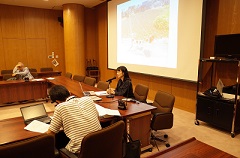 This presentation explores reconfiguration of the Badi community in Nepal after their association with prostitution became a matter of public policy and community controversies. The Badi, who are treated as Dalit, served in the past as entertainers for small rajas and landlords. They became increasingly dependent on income from women's sex work in the process of migration and urbanization in the 1960s. From the late 1980s, Badi women became identified as "high risk groups" by HIV/AIDS prevention projects. This identification generated various rumors and accusations among local residents, renewing discrimination and disputes related to questions of sex work, children's rights, citizenship, and property rights. In the late 1990s, Badi community residents began to fight against historical discrimination. They demanded legal rights for socially recognized marriage and family life. Because residents saw their community as being in the middle of social transformation, they made a clear distinction between the past and the present. Although they spoke eloquently about social change since the 1990s, little public discussion took place on the history of migration and the formation of new settlements between the 1960s and the 1980s. However, in backyards, women’s private talks illustrated how they made a collective strategy to move from rural villages in the hills to urbanizing towns, sustaining a dense kin network. This presentation addresses marriage norms by examining juxtapositions among individual experiences, family practices, and public debates.
This presentation explores reconfiguration of the Badi community in Nepal after their association with prostitution became a matter of public policy and community controversies. The Badi, who are treated as Dalit, served in the past as entertainers for small rajas and landlords. They became increasingly dependent on income from women's sex work in the process of migration and urbanization in the 1960s. From the late 1980s, Badi women became identified as "high risk groups" by HIV/AIDS prevention projects. This identification generated various rumors and accusations among local residents, renewing discrimination and disputes related to questions of sex work, children's rights, citizenship, and property rights. In the late 1990s, Badi community residents began to fight against historical discrimination. They demanded legal rights for socially recognized marriage and family life. Because residents saw their community as being in the middle of social transformation, they made a clear distinction between the past and the present. Although they spoke eloquently about social change since the 1990s, little public discussion took place on the history of migration and the formation of new settlements between the 1960s and the 1980s. However, in backyards, women’s private talks illustrated how they made a collective strategy to move from rural villages in the hills to urbanizing towns, sustaining a dense kin network. This presentation addresses marriage norms by examining juxtapositions among individual experiences, family practices, and public debates.
|
|
3. Maiko Annen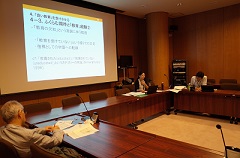 This presentation describes social changes in Nepal examined from the view of the daily life of a rural woman oriented to education. I first examined the meaning of “good education” and secondly considered the way of thinking and strategy for her son’s education. The national educational system in Nepal has been arranged since the 1950s. The construction of the educational system, connected with various rural development projects, was intended to provide equal opportunities for basic education of the masses. The person described herein was a learner of non-formal literacy education classes in my research field village. She desires to help her son get a “good education” and compels him to attend a private school in the city. He moves from place to place to obtain a “good education,” with dependence on relatives. When we consider her life history and household expenses, it is likely that her view of investment for education is reflected in her experiences of pleasure and suffering and in discourses related to development programs. Education is regarded as an opportunity to obtain future success and as a means of social mobility. I considered those situations in which expectations for education have increased, based on the education system of the last few decades in Nepal.
This presentation describes social changes in Nepal examined from the view of the daily life of a rural woman oriented to education. I first examined the meaning of “good education” and secondly considered the way of thinking and strategy for her son’s education. The national educational system in Nepal has been arranged since the 1950s. The construction of the educational system, connected with various rural development projects, was intended to provide equal opportunities for basic education of the masses. The person described herein was a learner of non-formal literacy education classes in my research field village. She desires to help her son get a “good education” and compels him to attend a private school in the city. He moves from place to place to obtain a “good education,” with dependence on relatives. When we consider her life history and household expenses, it is likely that her view of investment for education is reflected in her experiences of pleasure and suffering and in discourses related to development programs. Education is regarded as an opportunity to obtain future success and as a means of social mobility. I considered those situations in which expectations for education have increased, based on the education system of the last few decades in Nepal.
|
|
4. Kanako Nakagawa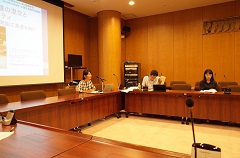 This presentation describes examination of the shifts in concepts of value related to buffalo meat brought about by a global market economy and explains how it led to social mobility, especially for a caste system in Kathmandu Valley, Nepal. Specifically examining the Khadgi caste, which has historically engaged in slaughtering, processing, and trading livestock as their caste-ordained role, and which has undergone discrimination as “low caste,” this study describes the meat market formation process and shifts in Khadgi’s strategies on their social movements. This case study revealed two values of buffalo meat: ‘prasada’, which means sacred food offered to a god or goddess, and as a ‘commodity’ circulated in the market. These two values are intermingled through the everyday life practices of Khadgi. Khadgi negotiates with Muslim brokers and Tibetan farmers in the market to update the local rules and norms related to meat as a ‘commodity’. However, Khadgi continue to sacrifice buffalo in a caste-based role, and distribute the ‘prasada’ to their market counterparts including Muslims and Tibetans. Consequently, the Khadgi’s caste identity is updated gradually, reflecting negotiations in the meat market. In 2008, the caste association of Khadgi decided to leave the governmental Dalit list, and to declare themselves as an ‘Adivasi Janajati (Indigenous Nationality)’ by emphasizing their culture and tradition. From the floor, scholars and researchers posed questions related to effects of global discourse on public hygiene, and related to caste studies in general, and similarity to other indigenous social movements.
This presentation describes examination of the shifts in concepts of value related to buffalo meat brought about by a global market economy and explains how it led to social mobility, especially for a caste system in Kathmandu Valley, Nepal. Specifically examining the Khadgi caste, which has historically engaged in slaughtering, processing, and trading livestock as their caste-ordained role, and which has undergone discrimination as “low caste,” this study describes the meat market formation process and shifts in Khadgi’s strategies on their social movements. This case study revealed two values of buffalo meat: ‘prasada’, which means sacred food offered to a god or goddess, and as a ‘commodity’ circulated in the market. These two values are intermingled through the everyday life practices of Khadgi. Khadgi negotiates with Muslim brokers and Tibetan farmers in the market to update the local rules and norms related to meat as a ‘commodity’. However, Khadgi continue to sacrifice buffalo in a caste-based role, and distribute the ‘prasada’ to their market counterparts including Muslims and Tibetans. Consequently, the Khadgi’s caste identity is updated gradually, reflecting negotiations in the meat market. In 2008, the caste association of Khadgi decided to leave the governmental Dalit list, and to declare themselves as an ‘Adivasi Janajati (Indigenous Nationality)’ by emphasizing their culture and tradition. From the floor, scholars and researchers posed questions related to effects of global discourse on public hygiene, and related to caste studies in general, and similarity to other indigenous social movements.
|
Workshop Report
MINDAS 2016 the first joint workshop Rethinking Family and Relatedness in South Asia
| Date: | Saturday, 30th July 2016. 13:00-18:00, Sunday, 31st 10:30-15:00 |
| Venue: | National Museum of Ethnology, Osaka |
| Presenter: | 1. Mizuho Matsuo (National Museum of Ethnology) “Introduction: Rethinking relatedness features in South Asia” |
| 2. Yumiko Tokita-Tanabe (Osaka University) “Relatedness Experienced in the Ritual of First Menstruation in Odisha, India” |
|
| 3. Sumie Nakatani (Kagoshima University) “Resistance to the market?: Forms of exchange in a Rajasthan Village” |
|
| 4. Noriko Katsuki (Chuo University) “Is a Navjote ceremony the gate of a Parsi community? How do Parsis try to maintain the quality of their community membership?” |
|
| 5. Yoko Taguchi (Hitotsubashi University) “Connections of Individual and Dividual: Mumbai’s Civic Activism and Psychometric Testing” |
|
| Summary: | 1. Mizuho Matsuo What are special features of social relations in South Asian society? This workshop was held to discuss the relatedness of individuals and groups such as family, kinship, caste, and religion, and to explore their manifestations in various social contexts, especially emphasizing India. The concept of relatedness here is used to elucidate the performative and constructive relations rather than biological (therefore, natural) kinship, proposed by Janet Carsten in the new kinship study. If one divides the question described above into more detailed questions, they would be the following: How do people create and live the relatedness of family, kinship, community, caste, and wider institutions such as religious and ethnic groups? How does that relatedness give reality for people? How does this reality bring categorical identification and formation? How does it create distinction (cutting of the relatedness) in the society? When one speaks about the basic nature of relatedness in Indian society, studies of caste and kinship and substance-code are those which are mainly discussed. Kinship in India is regarded as inseparable from caste because of its nature as given according to birth and principles of caste endogamy. It seems certain for any Hindu person that caste and kinship lend primal social relations in associating themselves with someone or something in the first place as well as in their daily lives. Many leading studies of caste and kinship have discussed those anyway regarding either category (descent) or behaviour (marriage rule). The study of a substance-code is related to the issues of personhood, folk concepts of conception, and criticism against Euro-American ethnocentrism of past kinship studies in anthropology. It has been discussed by Roland Inden, Ralf Nicolas, McKim Marriot, E. Valentine Daniel, and others that substance and code in Indian society are inseparable and that they are constituted as a ‘systematic monism’. The concept of substance-code can provide an interesting perspective for consideration of how a person is regarded as related with certain social relations and groups. These traditional studies that explore caste and kinship and substance-code surely constitute foundational factors for producing relatedness in Indian society. However, both tend to consider relatedness rather statically and fundamentally. It is insufficient to understand relatedness in contemporary Indian society through those perspectives alone. This panel, consisting of four papers describing girls’ puberty rituals in Odisha to physiological evaluation in ‘civil society’ movements in Mumbai, discussed the lived experiences of relatedness from individuals’ perspectives in contemporary India, which faces rapid transformation of social structure itself. |
| 2. Yumiko Tokita-Tanabe This study examined how the ritual process related to first menstruation in a village in Odisha led to people constructing and reconstructing their sense of belonging and relatedness to families, extended kin, and neighbourhood groups through sharing and exchange of substances. Particular attention was devoted to the experience of a girl who has menstruated for the first time. A transformation of the body-person of the girl occurs along with changes in the social relationships in which she is embedded. The presentation included a description of what happens when a girl discovers that she has started menstruating. She runs back to her house, where she is confined behind closed doors for three days. She bathes in a pond on the early morning of the fourth day, accompanied by seven married women whose husbands must be living. Only women and girls are allowed to see her until she has ritually fed young children on the fourth day after her bathing. Men and boys are said to break out in fever or heat boils if they see her before that. The family and relatives of the girl are reminded to think seriously about searching for her prospective marriage partner. Analysis of the ritual process suggests an explanation of how the occasion of the girl’s first menstruation triggers exchange relations and interactions that transform the social relations of various kinds centring round the girl. Construction and reconstruction of relationships occur based on kinship and community ties as well as inter-caste relations. The presentation also emphasized the importance of the emergence of a community of women representing auspiciousness and fertility, whose members guide the girl during the ritual process. The community of women enables the girl to control the excessive and harmful heat of first menstruation that parallels the dangerous aspect of the goddess’s power. Consequently, the network of relationships is not limited to the human social sphere. It is also a part of the cosmological realm of the goddess. By way of conclusion, I posed some questions for reassessment of the idea of substance in the analyses of personhood and interpersonal relations in South Asia. Substances can be shared and exchanged by touch, but can they be characterized as transferred by seeing, hearing, or smelling? I also suggested a re-examination of how sharing of space is linked to sharing and exchange of substances. |
|
| 3. Sumie Nakatani This study undertook reconsideration of earlier research conducted by myself in the 1990s from the perspective shared in the meeting. The agenda was a discussion of South Asian ways of connecting or assembling people. I emphasized the forms of exchange, which have not changed to date against market-oriented social change. In the studied village, the exchange of agricultural labour and other means of production such as land, water, seeds, and a tractor remain based on the sharecropping contract. Among marriage transactions, the most popular form is a sister exchange. It is an exchange by which two families exchange their women directly. It is regarded as an age-old system, but as demonstrated in the village, in a certain condition, the ‘traditional’ form has become more popular. In the festival, people exchange joy and satisfaction, i.e., locally called maza. To exchange maza through the annual festival is to confirm village community ties. The kind of festival that is popular in the village has changed from a traditional hierarchical one to a modern egalitarian one, but the exchange of maza remains extremely important. The question I raised in the presentation is that of why the forms of exchange are persistent, even though the meaning of exchange and the nature of relationships created by the exchange have changed entirely. How could the form of relationship be examined? I compared my findings for Rajasthan with the Micronesian exchange discussed by M. Strathern in her book Gender of Gift to examine the form or idea of the exchange specifically. Her idealism is suggestive to understand how the exchanges produce items and relations, and how the resultant relation is structured. However, the comparison between the South Asian case and Micronesian one is too challenging. It failed to capture the real picture related to a changing society. In a comment offered by a discussant, how the anthropological research of this kind could contribute to society was asked. |
|
| 4. Noriko Katsuki As one presenter, I described the actual status of Parsis in India as below at the MINDAS first meeting in 2016. The Parsis population in India has been extinguished more rapidly than expected. Nonetheless, their orthodox groups refuse to accept non-Zoroastrians who converted to Zoroastrianism in their community. Furthermore, the orthodox argues that Zoroastrianism is not a universal religion. The orthodox has become anxious that performing the Navjote ceremony confers to a convert a right to enjoy the welfare of the Parsi community. For Parsis, a Navjote ceremony is the Zoroastrianism initiation ritual. However, the Navjote was created as a tradition for children of rich Parsi merchants during the 15th century, after having parted with Iranian Zoroastrians geographically. Therefore, the Navjote is not a Zoroastrian ritual but rather a Parsi custom. In that sense, the orthodox tension is not irrelevant. However, when the orthodox maintains their attitude for a Navjote, they come up with a reason from the history of Zoroastrianism from Achaemenes to Sassanian. Even for the reformist who accuses the orthodox affirmation of being an anachronism, they use the same reason. Their historical perspective derives from the ancient history of Zoroastrianism and the era of the British raj. They do not devote attention to the era after the demolition of Sassanian and before the British raj. Therefore, their affirmation is irrelevant. From the floor, researchers and scholars posed questions related to the counterplot of Parsi population diminishment. Dr. Sugimoto, as a commentator, lent a new perspective to me about the abusiveness of a minority. |
|
| 5. Yoko Taguchi Indian “civil society” movements, especially those involving urban middle classes, have attracted media and research attention during the last few decades. This kind of movement has been criticized as representing a new consumerist middle class selfishly claiming their own desires at the expense of poor people. The urban activists indeed uphold individual merit and apparently work for their own benefit. In my fieldwork in Mumbai, however, I was more intrigued by the activists’ particular interests and somewhat contradictory approach to themselves. These Mumbai activists’ core value was “integrity,” emphasizing honesty, wholeness, and undividedness. In pursuit of this ideal of individual citizenship, however, they produce the repeatedly re-appearing contradictory figure of the relationally defined dividual, created through the transaction of substance-codes. This paper presents analyses of this complex movement through an examination of two concepts of dividuality. One concept relates to the thesis of a general psychologization and technologization of contemporary society, which renders people as fragmented data. This description, however, does not fit with the narratives of Mumbai activists, who reported personal “satisfaction” as their motivation, but in partial association with the idioms of the karmic code. Here, the logic of psychologization (e.g., doing social work to gain satisfaction) and the logic of karma (having to do one’s work without being able to control its effects) both worked in support of civic duty. Therefore, to elucidate the making of citizens, the dividualization of contemporary society must be complemented with the dividual constructed through the movements of substance-codes. I analyzed the use of psychometric tests by Mumbai’s citizen campaign organization in selecting suitable political candidates to illustrate the paradoxical manner in which individual citizens are pursued by partial connections across different forms of dividuals. The device of psychometrics was important for evaluating citizens as independent individuals, who were uncovered through the integration of pure inner data, without consideration of their external relations such as religion, caste, or family background. This was how the dividuals of psychologization and technologization played out. However, when the test takers were actually evaluated by a psychometrics trainer in this case, their data were interpreted through the concept of unchangeable “culture” and the relations that created the person. Therefore, another kind of dividual appeared in the test results. The global logic of citizens is indeed important for contemporary Mumbai activism. Nevertheless, it is neither that the universal civic logic overtakes the Indian logic nor that the latter absorbs the former. Instead, new interpretations and practices are explored in the movements and connections of substances and codes. |
|

